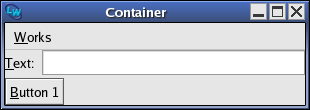





You will frequently need to organize a number of different elements in rows and columns. The column-layout and row-layout elements are provided to make this easy.
The following is a simple example showing the use of column-layout.
(contain (make-instance 'column-layout
:description (list
(make-instance 'text-input-pane)
(make-instance 'list-panel
:items '(1 2 3 4 5)))))
An example of using column-layout

(setq button1 (make-instance 'push-button
:data "Button 1"
:callback 'test-callback))
(setq button2 (make-instance 'push-button
:data "Button 2"
:callback 'test-callback))
(setq editor (make-instance 'editor-pane
:text "An editor pane"))
(setq message (make-instance 'display-pane
:text "A display pane"))
(setq text (make-instance 'text-input-pane
:title "Text: "
:title-position :left
:callback 'test-callback))
These will be used in the examples throughout the rest of this chapter.
To arrange any number of elements in a column, create a layout using column-layout, listing the elements you wish to use. For instance, to display title, followed by text and button1, enter the following into a Listener:
(contain (make-instance 'column-layout
:description
(list text button1)))
A number of elements displayed in a column

To arrange the same elements in a row, simply replace column-layout in the example above with row-layout. If you run this example, close the column layout window first: each CAPI element can only be on the screen once at any time.
Layouts can be given horizontal and vertical scroll bars, if desired; the keywords :horizontal-scroll and :vertical-scroll can be set to t or nil, as necessary.
When creating panes which can be resized (for instance, list panels, editor panes and so on) you can specify the size of each pane relative to the others by listing the proportions of each. This can be done via either the :y-ratios keyword (for column layouts) or the :x-ratios keyword (for row layouts).
(contain (make-instance 'column-layout
:description (list
(make-instance 'display-pane)
(make-instance 'editor-pane)
(make-instance 'listener-pane))
:y-ratios '(1 5 3)))
You may need to resize this window in order to see the size of each pane.
Note that the heights of the three panes are in the proportions specified. The :x-ratios initarg will adjust the width of panes in a row layout in a similar way.
It is also possible to specify that some panes are fixed at their minimum size while others in the same row or column adjust proportionately when the interface is resized:
(contain
(make-instance
'column-layout
:description
(list
(make-instance 'output-pane
:background :red
:visible-min-height '(:character 1))
(make-instance 'output-pane
:background :blue
:visible-min-height '(:character 1))
(make-instance 'output-pane
:background :red
:visible-min-height '(:character 3)))
:y-ratios '(1 nil 3)
:title "Resize this window vertically: the red panes maintain ratio 1:3, while the blue pane is fixed."
))
To arrange panes in your row or column layout with constant gaps between them, use the :gap initarg:
(contain
(make-instance
'column-layout
:description (list
(make-instance 'output-pane
:background :red)
(make-instance 'output-pane
:background :white)
(make-instance 'output-pane
:background :blue))
:gap 20
:title "Try resizing this window vertically"
:background :gray))
To create resizable spaces between panes in your row or column layout, use the special value nil in the layout description:
(contain (make-instance 'column-layout
:description (list
(make-instance 'output-pane
:background :red)
nil
(make-instance 'output-pane
:background :white)
nil
(make-instance 'output-pane
:background :blue))
:y-ratios '(1 1 4 1 1)
:title "Try resizing this window vertically"
:background :gray))
CAPI User Guide and Reference Manual (Unix version) - 01 Dec 2021 19:32:34